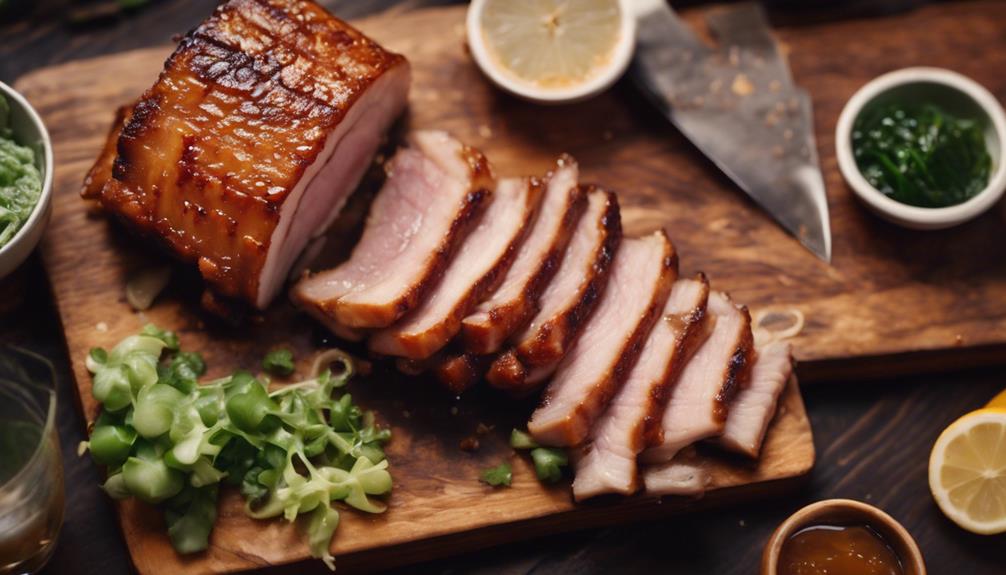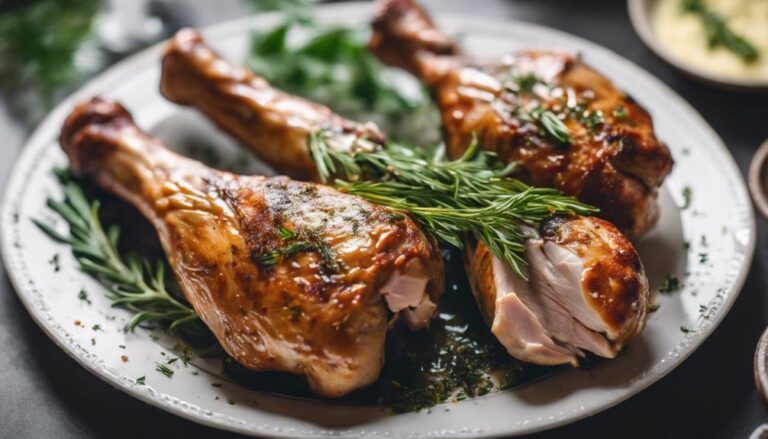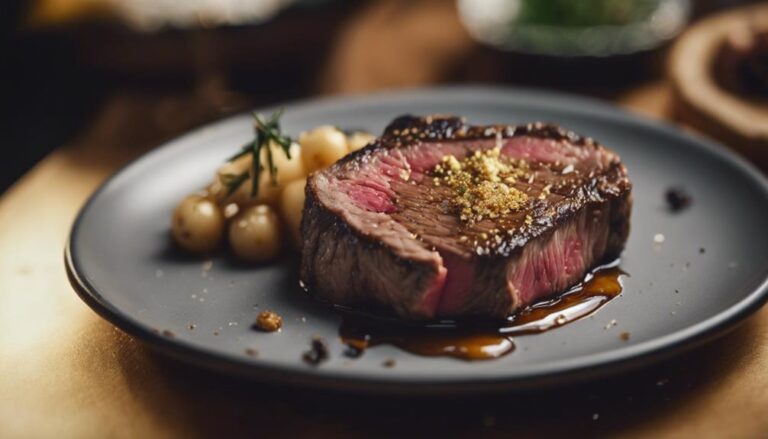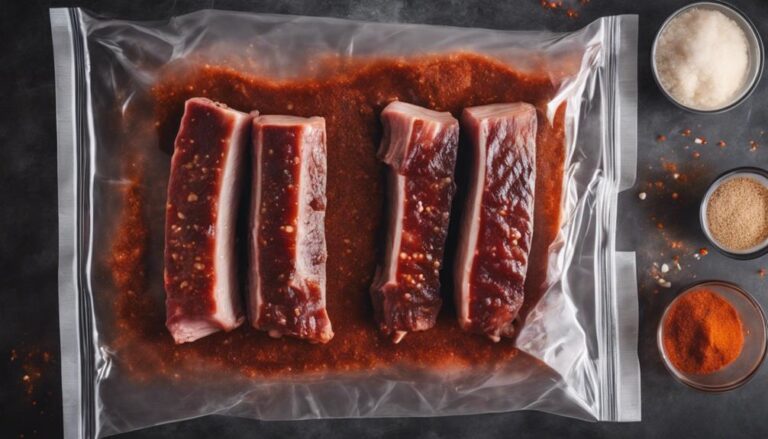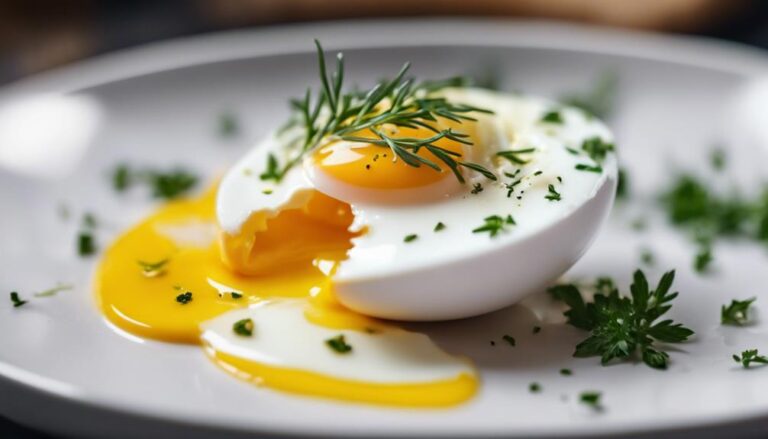Sous Vide Pork Belly: A Crispy Morning Start
Indulge in the mouthwatering delight of tender pork belly, sous vide to perfection, promising a crispy start to your morning. Sealing in a bag at precise temperatures guarantees even cooking and a succulent texture. Seal the deal with a hot pan sear for that desired crispy finish. Elevate your culinary experience by experimenting with different marinades like gochujang or teriyaki. For the crunch you crave, score the skin, apply a dry rub, and scald before sous vide. Your journey to flavorful, crunchy pork belly begins now. Uncover the secrets to a perfect crispy morning treat.
What You Will Learn Here
- Marinate pork belly with brown sugar, gochujang, soy sauce for flavor.
- Score skin for crispy texture and fat rendering.
- Sous vide at 57C/135F for 48 hours for tender meat.
- Sear skin in hot oil for a crispy finish.
- Experiment with pre-smoking or air frying for variation.
Origin of Sous Vide
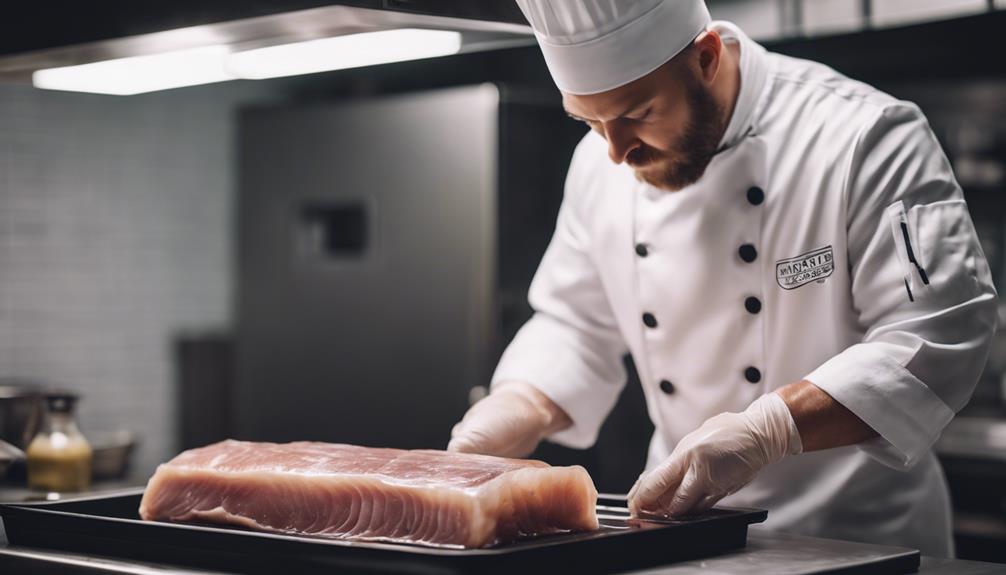
Sous vide cooking, with its roots in 1970s France, revolutionized culinary techniques by introducing a method that hinged on precision and consistency.
The term 'sous vide,' meaning 'under vacuum,' underscores the method's reliance on sealed bags to cook ingredients at precise temperatures.
The evolution of this technique not only marked a significant culinary innovation but also highlighted the importance of meticulous temperature control in achieving superbly cooked dishes.
Sous Vide History
Originating in France during the 1970s, the technique of sous vide cooking was introduced by Chef Georges Pralus as a method to guarantee precise and consistent results in the culinary world. The term 'sous vide' translates to 'under vacuum,' highlighting the use of vacuum-sealed bags in the cooking process. Initially developed for cooking foie gras, sous vide gained popularity in professional kitchens for maintaining ingredient integrity and enhancing flavors. This method revolutionized the culinary scene, offering a way to achieve unparalleled results. Below is a table summarizing key aspects of sous vide history:
| Aspect | Description |
|---|---|
| Origin | France, 1970s |
| Pioneer | Chef Georges Pralus |
| Initial Purpose | Cooking foie gras precisely and consistently |
| Impact | Popular in professional kitchens for enhancing flavors and ingredient integrity |
Technique Evolution
Evolutionizing from its roots in precise cooking for foie gras, the sous vide technique underwent a significant transformation that propelled it into the domain of culinary innovation and excellence.
Originally used for delicate ingredients like foie gras, sous vide has now expanded to a variety of foods, including pork belly. When you cook pork belly sous vide, the method involves sealing the meat in a vacuum-sealed bag and cooking it in a water bath at a precise temperature. This process guarantees that the pork belly cooks evenly, resulting in a tender texture.
To achieve a crispy skin on the pork belly after sous vide cooking, a quick sear in a hot pan is often added to enhance the texture and flavor.
Culinary Innovation
Culinary innovation in the domain of exact cooking techniques saw a significant shift with the introduction of sous vide in the 1970s. This cooking technique revolutionized the culinary world by offering chefs precise temperature control to achieve consistently tender and juicy results, especially evident in dishes like pork belly. Sous vide involves vacuum-sealing food in bags and cooking it in a water bath, ensuring even cooking and moisture retention. The method's ability to maintain the integrity of flavors and nutrients has made it a favorite among professionals and home cooks alike. Below is a table highlighting the key features of sous vide cooking for pork belly:
| Key Features | Description |
|---|---|
| Tender Texture | Sous vide ensures pork belly is cooked to perfection, yielding a tender bite. |
| Juicy Result | The precise cooking method retains the pork belly's natural juices, enhancing its flavor. |
| Crispy Finish | Sous vide sets the stage for achieving a crispy exterior when finished with a quick sear. |
| Precise Temperature Control | Maintaining consistent temperatures throughout cooking guarantees the best results. |
Pork Belly Marinade Components
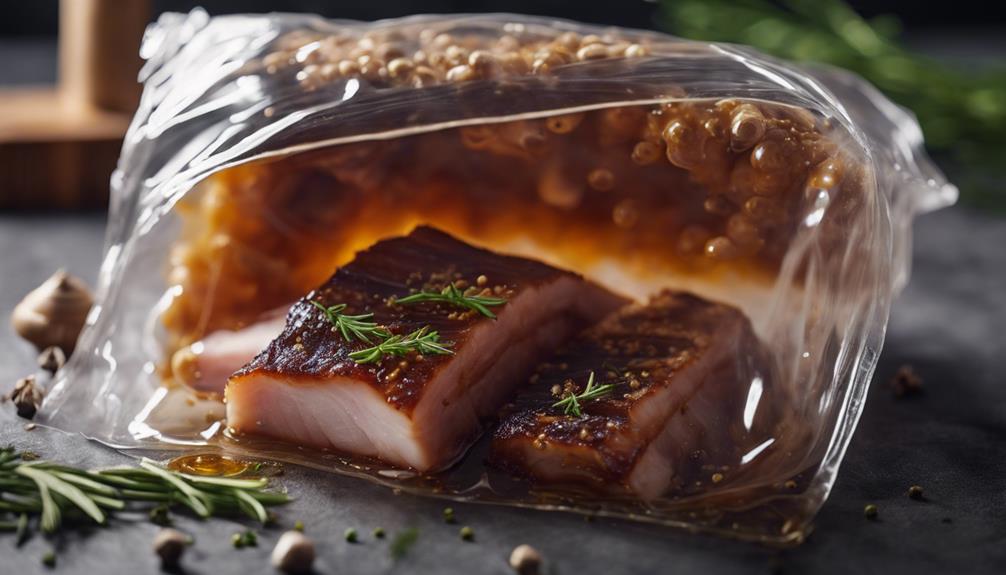
To create a flavorful marinade for pork belly, combine brown sugar, gochujang, soy sauce, fish sauce, ginger, and garlic for a sweet, sticky, and savory taste enhancement. This combination of ingredients not only adds depth and complexity to the pork belly but also helps infuse the flavors into the meat for a more delicious end result.
Here are the key components of the pork belly marinade:
- Brown Sugar: Provides a touch of sweetness that caramelizes beautifully when cooked.
- Gochujang: Adds a hint of spiciness and depth of flavor with its fermented chili paste base.
- Soy Sauce: Offers a savory umami flavor that complements the richness of the pork belly.
- Fish Sauce: Introduces a unique salty and savory element that enhances the overall taste profile of the dish.
Sous Vide Pork Belly Variations
When exploring sous vide pork belly variations, consider trying different marinades like teriyaki or bulgogi to infuse unique flavors into the dish.
Experimenting with various cooking times and temperatures allows you to tailor the tenderness and juiciness of the pork belly to your liking.
Enhancing the flavor and texture of the pork belly through pre-smoking and post-searing techniques can elevate the overall dining experience.
Savory Sous Vide Pork Belly
For a delectable twist on traditional pork belly, infuse your savory sous vide pork belly with a mouthwatering marinade of brown sugar, gochujang, soy sauce, fish sauce, ginger, and garlic to achieve a sweet, sticky, and savory flavor explosion. Marinating the pork belly enhances its taste by allowing the flavors to penetrate the meat for up to 24 hours before cooking. Cooking the pork belly sous vide at 165 degrees F for 8-10 hours results in tender meat with flavorful results. Your finishing options include smoking for a smoky flavor, oven baking for a crispy exterior, or using an air fryer for pork belly bites with various textures and flavors. Experiment with different finishing methods and flavor enhancements to create the perfect sous vide pork belly with a crispy skin.
- Marinate pork belly with brown sugar, gochujang, soy sauce, fish sauce, ginger, and garlic.
- Allow marination for up to 24 hours before cooking.
- Cook sous vide at 165 degrees F for 8-10 hours.
- Experiment with smoking, oven baking, or air frying for different textures and flavors.
Crispy Pork Belly Slicing Guide
Enhance the crispy texture of your sous vide pork belly by expertly slicing it to optimize the balance of tender meat and crunchy skin. When it comes to slicing your pork belly, follow these steps for the best results:
- Score the Skin: Make shallow cuts across the skin to help render the fat and crisp up the skin during the searing process.
- Seasoning: Make sure the skin is well seasoned with a dry rub of salt, pepper, and sugar to enhance the flavor and texture of the crispy skin.
- Sear: After sous viding, pat the skin dry and sear it in a hot pan to achieve a golden, crunchy finish.
- Gelatin Conversion: Sous vide the pork belly for 48 hours at 57°C/135°F to convert collagen to gelatin, resulting in a moist and tender meat texture.
Pork Belly Sous Vide Toppings
To elevate the flavors and textures of your sous vide pork belly, consider experimenting with a variety of toppings such as crispy garlic chips, pickled red onions, fresh herbs, and more. Here are some topping ideas to enhance your pork belly dish:
- Crispy Garlic Chips: Add a satisfying crunch and a burst of garlicky flavor to complement the rich pork belly.
- Honey or Maple Syrup: Drizzle a touch of sweetness to balance the savory richness of the pork belly.
- Zesty Fruits: Incorporate zesty fruits like pineapple or mango salsa for a invigorating contrast that enhances the overall dish.
- Spicy Elements: Kick up the heat with chili oil, sriracha, or jalapenos to create a dynamic flavor profile that complements the sous vide pork belly perfectly.
Crispy Skin Secrets
To achieve the desired crispy skin on your sous vide pork belly, you'll want to master some key techniques.
Scoring the skin, applying a dry rub, and scalding the meat are essential steps for ideal fat rendering and flavor infusion.
Ensuring a crunchy texture and a perfectly crispy finish will elevate your pork belly dish to new heights.
Skin Crisping Techniques
For achieving a perfectly crispy skin on your sous vide pork belly, consider incorporating these proven techniques and secrets.
Start by scoring the pork belly skin to aid fat rendering during cooking. Apply a dry rub containing salt, pepper, and sugar to enhance flavor and texture. Avoid any unpleasant odors by scalding the meat in hot water before sous vide cooking.
Guarantee crispiness by drying the skin in the oven at a low temperature. Finally, achieve a crispy finish by searing the skin on medium heat with generous oil.
These steps will help you master the art of creating a delectable and crunchy skin on your sous vide pork belly, delighting those you serve.
Achieving Crunchy Texture
Scoring the pork belly skin is the initial step towards achieving a crunchy texture that will elevate your sous vide pork belly dish to new heights. By making shallow cuts across the skin, you allow for fat rendering during cooking, leading to a crispy finish.
Before sous vide cooking, applying a dry rub of salt, pepper, and sugar enhances the flavor and helps in creating a crunchy skin when seared. To further guarantee a delightful crunch, scald the meat in hot water beforehand to eliminate any undesirable odors.
Drying the skin in the oven at a low temperature will help maintain crispiness without risking burning. Finally, when ready to serve, sear the skin on medium heat in a generous layer of oil to achieve that perfect crispy finish.
Tips for Crispy Finish
Enhance the pork belly's crunch factor by incorporating a dry rub of salt, pepper, and sugar before the sous vide cooking process.
To guarantee a crispy finish, score the pork belly skin to aid in fat rendering and crispiness.
Prior to sous vide cooking, scald the pork belly in hot water to eliminate any unpleasant odors.
After sous vide, dry the skin in the oven at a low temperature to enhance its crispiness.
When ready to serve, sear the skin in a generous amount of oil on medium heat to achieve the desired crispy texture.
These steps will help you master the art of creating a perfectly crispy skin on your sous vide pork belly, delighting your guests with every bite.
Final Thoughts
In considering the overall process and results of this sous vide pork belly recipe, it becomes evident that attention to detail and experimentation in finishing techniques can truly elevate the dish to a new level of culinary delight. Achieving the perfect crispy skin on the pork belly involves a meticulous process of scoring, drying, and searing, which ultimately enhances the texture and flavor profile.
The sous vide cooking method at 57C/135F for 48 hours guarantees a tender and moist meat without compromising the natural fats. Additionally, scalding the meat beforehand at 75C/170F helps in eliminating any unwanted odors during the sous vide process. It's essential to use a weight to flatten the pork belly during cooking to ensure even results throughout.
Frequently Asked Questions
How Do You Crisp Pork Belly After Sous Vide?
To crisp up pork belly after sous vide, you can achieve a delightful texture by oven broiling, air frying, pan searing, using a blowtorch finish, deep frying, grill finishing, or opting for a cast-iron skillet.
Why Didn't My Pork Belly Go Crispy?
To guarantee your pork belly turns crispy, focus on temperature control for fat rendering. Adjust cooking time, dry the skin thoroughly, score it, consider brining, and utilize broiling for that perfect crunch.
How Do You Keep Pork Belly Crispy the Next Day?
To keep your pork belly crispy the next day, store it airtight in the fridge. When reheating, use the oven at 350F for 10-15 minutes, spooning pan juices over it. For extra crispiness, consider an air fryer or a broiler finish.
Should I Season My Pork Belly the Night Before?
Seasoning your pork belly the night before is a smart move. Brining benefits, dry rubs, or marinade mistakes can be avoided. Salt solutions enhance flavor infusion. With overnight marinating, your pork belly will have a well-developed taste profile.
Conclusion
You've perfected the art of sous vide pork belly, achieving the ideal balance of tenderness and crispiness. The marinade elements and alterations have elevated the flavors to new levels.
The keys to achieving that crunchy skin have been revealed, leaving you with a delightful breakfast choice that will have you returning for more.
Keep experimenting and honing your technique to create the ultimate sous vide pork belly dish for a crispy morning start.
